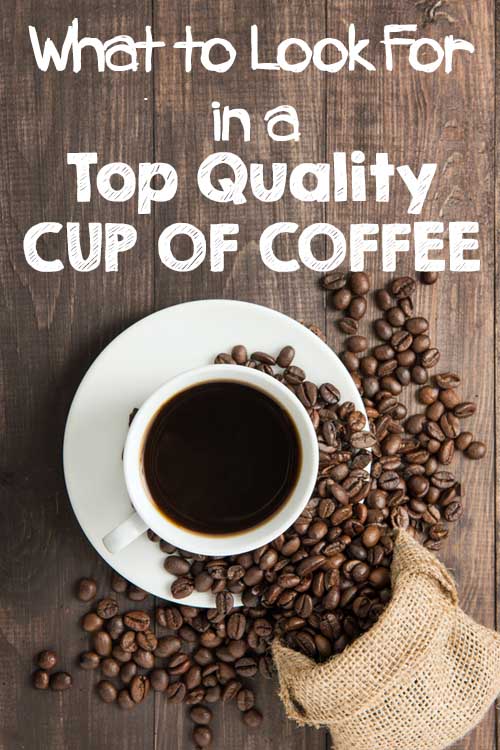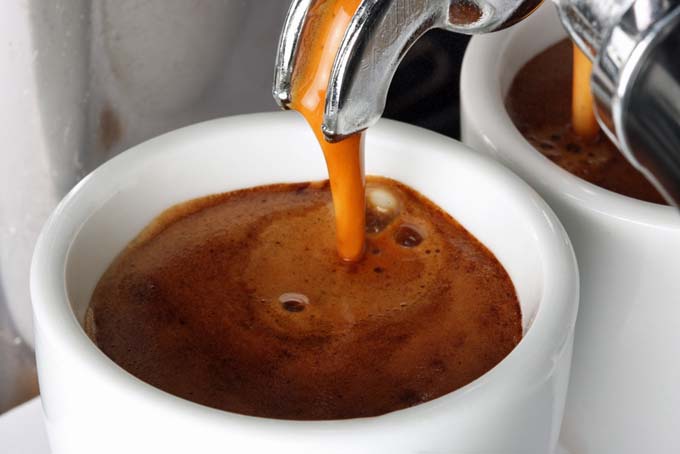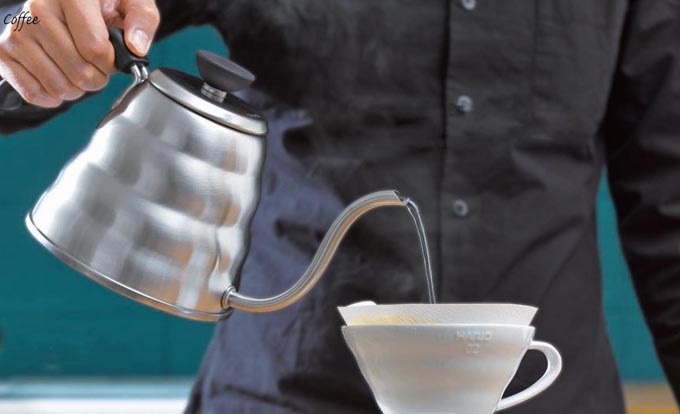Carefully-brewed homemade using a home espresso machine or premium drip coffee makers along with true barista-crafted coffee will beat out truck-stop coffee almost every time, especially if it’s been sitting out for hours.
But why?

And does it really make enough of a difference to justify coffee shop prices?
Can you improve on the often burnt and over sweetened coffee offered from the chains? This is up to you of course, but here are a few things to look for in assessing your local purveyor of caffeinated beverages.
Quality + Skill
It’s hard to overstate coffee’s complexity.
When stores skimp on quality by using inexpensive beans, stale grounds, or blended coffees from multiple origins, it removes the distinct top notes of different regions and roasts. Ask where your local shop gets their beans
Combining good quality coffee with skillful extraction can elevate your cup from blah to delicious.
But achieving the proper extraction requires practice, so whatever brew method you choose, give yourself some time to try out different brew times, water temperatures, and bean quantities.
You might also want to consider what carafe to use, in order to keep that beautifully brewed coffee of yours hot.
For true precision, you can even purchase a kitchen scale and weigh out your grounds and water so you use exactly the same proportions of grounds to water each time you brew.
Avoiding Bitterness
The biggest flavor to avoid – and most peoples’ reason for adding cream and sugar – is bitterness.
Over-roasted beans or a long stint on the warmer after brewing can burn the sugars in the coffee, and over-extraction (steeping too long or using too few grounds) can pull out bitter flavors buried deep inside the bean.
If your local coffee suffers from bitterness, it’s not a good sign and you might want to try another shop.
There is a difference between bitter coffee and strong coffee, however, and if you’re used to dosing up with cream and sugar, it may take a while for your brain to be able to tell the difference.
If the coffee’s strength is the problem, try diluting it with a little water and see if it’s more to your tastes. If the bitter flavors are still at the forefront, then something went wrong on the shop’s end or it’s just not a good fit for your preferences.
Time to doctor it up!
Milk Drinks
Steamed and foamed milk beverages like lattes and cappuccinos should have creamy foam toppings with tiny, uniform bubbles.
Dry foam with big bubbles won’t have the same smooth, caramelly flavors as properly heated milk. If your drink has a pretty design on the top, the milk has probably been foamed properly.
Crema
If you prefer espresso, one way to judge the quality is by the crema, the layer of foam on top of a freshly-pulled shot.

It should be dark brown with tiny, almost invisible bubbles. The crema disappears in under a minute, so if your espresso doesn’t have this foam cap, it’s probably been sitting around awhile.
If the foam is very light in color, the coffee may be under-extracted, so you might try elsewhere for your caffeine fix.
Fortunately, well-crafted coffee is becoming easier to find all around the world. Armed with a little knowledge (and some helpful coffee lingo), you’ll know how to spot a gem in your local neighborhood. And you can start brewing it correctly at home, with the right tools and ingredients! Good beans, a strong grinder, and a top-rated espresso machine are all amazing gift options, by the way.
Happy hunting!
What do you look for in a new coffee shop? Let us know in the comments!
About Mike Quinn
Mike Quinn spent 20 years in the US Army and traveled extensively all over the world. As part of his military service, Mike sampled coffee and tea from all virtually every geographic region, from the beans from the plantation of an El Salvadorian Army Colonel to "Chi" in Iraq to Turkish Coffee in the Turkish Embassy in Kabul, Afghanistan. He spent nearly a decade in the Republic of Korea where he was exposed to all forms of traditional teas. Mike formerly owned and operated Cup And Brew, an online espresso and coffee equipment retail operation.




This has given me quite an education today! For as much as I’ve always enjoyed coffee, a lot of this was information that I hadn’t a clue about before reading this.
Actually I’m wondering right now if I’ve ever in my life even *had* a cup of “real” coffee… I suspect not. (By “real” I mean the delicious kind after taking all these things into consideration before buying it.)
I’m not real fond of “the big popular chain’s” coffee no matter all the hoopla surrounding it… just could never tolerate it very well and never knew what all the hype was about. 🙂
My major complaint concerning coffee is the bitterness that so much of it seems to have… just don’t like that.
Kate,
Don’t let the “the big popular chains” full you. They use overpriced old and stale beans. It’s one of the reasons (of many) they over so many flavored and decked out beverages. Whipped cream oh my! It’s to cover up the taste of their nasty base brew.
And nowadays, the workers are far from being trained baristas.
I would not trust the big guys in almost every industry that you are looking at, so I can certainly see that being an important thing here. I must admit that I buy a more general ground coffee for my everyday stuff, just because it is cheaper, but I definitely notice the difference in taste when the beans are better quality.
Great tips. I think you debunked the reason why I don’t like black coffee at my local coffee shop – bad brewing habits. I prefer to drink black coffee because I like to flavor and I don’t like to load it with calories. But with strong, bitter flavors, I have never been able to truly enjoy a black cup. I always need to add milk or cream.
These tips are good to know. I’ve often wondered why some coffee shops have great coffee and in others, I’m not impressed. Some, I’ve never gone back to. I’m not a big fan of the chain shops – that’s for sure.
I’ve only recently begun to learn about the good stuff. My husband likes to dig into stuff and learn all he can, and since I love a good cup of java, he’s begun researching and teaching me things.
I’ll add this article to my list. He’ll probably find it interesting as well.
Thanks for the reply Zyni, I am the same as your husband…sometimes too much research and then I have the absurd need to really go overboard in my projects. Which is one of the reasons this site exists I guess…it’s a project.
My brother is a very well educated and seasoned Barista. He has shared these same tips with me many times! There’s a lot of education that goes into making the perfect cup, that’s why I think if you can find an amazing and knowledgeable coffee shop, it is well worth the money to let them make you a great cup!
Of course it is fun to learn how to make the perfect cup at home, but sometimes I fear I’ll never master all the facets of it, and I do love my local cafes!
Your quest for the perfect cup at home is doable with any convention method. Whether it be pour over, automatic drip, or the French press. Espresso on the other hand, lots of trial and effort, and dialing your equipment for that.
Enjoyed reading this article and loved how it was in a easy to read format.
I recently got a new job that requires a long commute and I’ve been searching for a good cup to keep me going, but the regular retail stuff always fell short. I’ve always felt it was because of the quality of the ingredients.
Will definitely use your tips to go find a few “hole in the wall” places to get my caffeine fix.
This is really useful. I entertain regularly and having the understanding of what makes a good cup is helpful when making a batch for others. I am not a coffee drinker so I have no luck with taste testing to perfect my brew. I like that this information actually tells me what to look for as well as the taste. It is interesting that you distinguish between a strong taste and bitterness.
I am a coffee drinker who honestly knows nothing about the whole “culture” except for how much cream and sugar i want with my cup. This was simple and informative for any novice to be able to follow and learn. You couldn’t be more right when you said that most times we drown the cup with cream and sugar in an attempt to rid our tastebuds of the bitterness (which I was unaware was due to other factors other than the grounds being bitter in nature).
Great information and links Mike!
I always used to have to really doctor up my coffee, I went to a local shop because it was the cheapest.
About a year ago on a trip to Canada I had this amazing cup from a little shop.
It tasted better black then anything I had ever had!
The young man who ran the shop really knew his stuff and sourced the beans himself.
Makes the world of a difference!
If anyone has not tried a REAL good cup of Joe, I highly suggest taking this tips in mind and finding a good coffee spot.
For about $20, I can tell you the one thing that your brew-at-home coffee pot can’t match.
The French Press. It’s simple to use, relatively cheap, easy to clean, and makes the best freakin’ coffee you’ve ever had, at least compared to a counter top percolator. It’s essentially as easy as brewing a cup of tea, and it can even be used as a tea infuser if you’ve got loose leaf laying about.
Just put the kettle on and pour it over the grounds, give it a stir, and then put the plunger in. It makes coffee in a way that it’s hard to explain, but in my experience it can even pull slight chocolate notes from store-bought Folgers.
I would agree with DrunkChicken – for a home brewed batch, I cannot find a better coffee maker than a classic french press/cafetiere. There is something so satisfying about watching the liquids brew in the glass pot and then feeling the resistance when you push the filter down to collect the grounds at the base. And the taste is always exquisite.
I have one of those new-fangled devices that takes pods, but it always comes out tasting too sweet or not strong enough, and the equipment is such a bore to clean. With a french press, all you need to do is take the lid off (filter plunger is usually attached), rinse and wash, wash the pot and you’re done.
You can now buy smaller french presses that just make one cup of Joe, and there is even a travel mug you can buy with a french press built in, so you can make it to go or brew it in the office. I have one myself and its a God send.
French presses do make an excellent brew, no argument there, although I’d disagree about the glass carafe part of it. I’m absolute in love with the Espro Press and have been for several years…double lined stainless steel body with a double filtration system. Check out my review on it:
https://foodal.com/drinks-2/coffee/french-press/espro-review/
That being said, don’t be so quick to discount the automatic drip models. The newer, top of the line models have the ability to heat water to the correct temperature range (and can even dial down for different types of tea) and the best ones have the ability to adjust the temp and even run the machine through a bloom cycle (https://foodal.com/drinks-2/coffee/guides-coffee/what-is-bloom/) before brewing.
You want to look for the ones that have the SCAA endorsement:
https://foodal.com/category/drinks-2/coffee/brewers/
Check out the tab that says automatic drip pots for more info on those.
I suggest that the Behmor Brazen is a likely candidate where price meets features:
https://foodal.com/drinks-2/coffee/brewers/behmor-brazen-brewer/
Enjoyed reading this article! I’m not a big fan of coffee, as the large amounts of caffeine are not healthy for me, but it was interesting reading about how you determine coffee quality. It intrigued me when I read that coffee is not bitter if you brew it correctly. I’ve tried coffee a few times, and it’s always tasted bitter unless I used some cream and sugar. I guess that means that all the coffee I’ve tried is low quality, but I guess that’s expected from McDonalds. What is the taste difference between Strong and Bitter coffee?
I am a big black coffee drinker and this article makes me think, do I have bad taste? The bitterness of black coffee is the reason I prefer it to cream and sugar. I never knew bitterness was a bad thing. Now, I don’t enjoy the burnt quality that gas station coffee often has, but I still like my coffee to have a bit of a kick behind it. Can you elaborate on the difference between strong and bitter more?
This guide is a pretty basic one, but quite accurate with its information concerning coffee. There is nothing in the world I hate worse than bitter coffee. I literally have stopped going to eat at some breakfast establishments altogether simply because their coffee wasn’t up to par. If you run a breakfast diner or eatery, I honestly think the quality of your standard joe can make or break your success.
I like how you pointed out that milk beverages should have creamy foam toppings with tiny, uniform bubbles, and that dry foam with big bubbles doesn’t have the same smooth, caramelly flavors as properly heated milk. I wonder if the type of brewer has a big effect on the quality of the coffee, and how offices and businesses manage the upkeep of their brewers and the stock of coffee that they have.